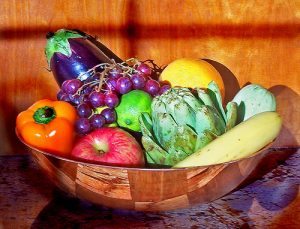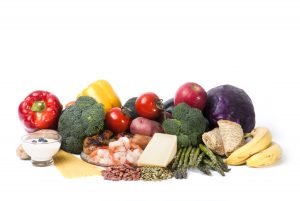Last week, US News and World Report listed their picks for the best diets for 2018. The #1 spot was a tie between the DASH Diet and the Mediterranean Diet. 3rd place went to the Flexatarian Diet. All top three diets listed by US News and World Report are lifestyle diets. The top three diets challenge people to plan ahead their meals, cook more at home, and increase their intake of fruits and veggies. Let’s take a closer look at each of the top three diets.
DASH Diet

photo credit: Trace Nietert Eat healthy fruits and veggies bowl via photopin (license)
The DASH diet stands for Dietary Approaches to Stop Hypertension. It is a lifelong approach to healthy eating that is designed to help treat and prevent high blood pressure. It encourages people to reduce their sodium intake by eating more whole grains, fruits, and vegetables and other foods that are rich in nutrients that help to lower high blood pressure such as potassium, calcium, and magnesium. Furthermore, the DASH dietary guidelines are also known to help prevent or reduce the risk of osteoporosis, cancer, heart disease, stroke and diabetes. Key emphasis is on consumption of veggies, fruits and low-fat dairy with moderate intake of whole grains, fish, poultry and nuts.
Mediterranean Diet
The Mediterranean Diet is a meal plan similar to the DASH diet, but it includes olive oil as its main fat and the occasional glass of red wine. It is based on the cooking style of countries that border the Mediterranean Sea. At the base of this diet are veggies, fruits, followed by fish, whole grains and heart healthy fats (olive oils, nuts, seeds). Red meat and animal sources of fat are limited with very low intakes of saturated fat. Research has shown that the traditional Mediterranean diet reduces the risk of heart disease by lowering the level of oxidized LDL cholesterol (bad cholesterol) within the arteries. The Mediterranean diet is also associated with a reduced incidence of cancer, Parkinson’s and Alzheimer’s diseases. Many of the fruits and veggies typically consumed in a Mediterranean diet are naturally anti-inflammatory and filled with powerful antioxidants and phytochemicals, known to reduce inflammation and protect against oxidative stress within the body.
Flexatarian Diet
 The third diet is relatively new, at least by name. The Flexatarian diet is a fancy way of following a semi-vegetarian diet, which is primarily a plant-based diet but also includes occasional small servings of meat, low-fat dairy, eggs, poultry and fish. The benefits of a vegetarian diet include reduced risk of heart disease, diabetes and some cancers. I personally like this sort of vegetarian diet since it closely stays in line with the DASH and the Mediterranean diet for animal sources of protein, but the Flexitarian diet as more emphasis on getting protein from plant-based sources (whole grains and legumes).
The third diet is relatively new, at least by name. The Flexatarian diet is a fancy way of following a semi-vegetarian diet, which is primarily a plant-based diet but also includes occasional small servings of meat, low-fat dairy, eggs, poultry and fish. The benefits of a vegetarian diet include reduced risk of heart disease, diabetes and some cancers. I personally like this sort of vegetarian diet since it closely stays in line with the DASH and the Mediterranean diet for animal sources of protein, but the Flexitarian diet as more emphasis on getting protein from plant-based sources (whole grains and legumes).
Take Home Message
Which diet is the absolute best? I would recommend the one that you are most comfortable with and find the most enjoyable. The top three diets simply vary by cooking methods and the quantities of protein, low-fat dairy products, and fats. All of the top three diets promote increased intakes of fruits and veggies. Increasing your intake of fruits and veggies allows you to increase your intake of vitamins, minerals, anti-inflammatory nutrients, natural phytochemicals and fiber. These nutrients work together to help reduce the risk of debilitating chronic diseases such as diabetes, heart disease, high blood pressure, cancer, and some neurodegenerative disorders.
Balance among the key food groups (complex carbs, lean proteins, and heart healthy fats) is my philosophy of healthy eating. All of the top three diets promote balanced eating. An easy way to mimic any of the top three diets is to make your plate ½ full of fruits and veggies, ¼ full of lean protein (fish, poultry, lean cuts of pork or beef) and ¼ full of whole grains (wild rice, quinoa, bulgur, or farro). By embracing a more balanced eating plan filled with more fruits and veggies and other plant-based foods you will find yourself feeling fuller for longer periods of time. This is in large part due to the increased fiber and water intake that comes along with the increased intakes of fruits and veggies. Not only will your body thank you for increased intake of fruits and veggies, but your waistline will too.

0 Comments